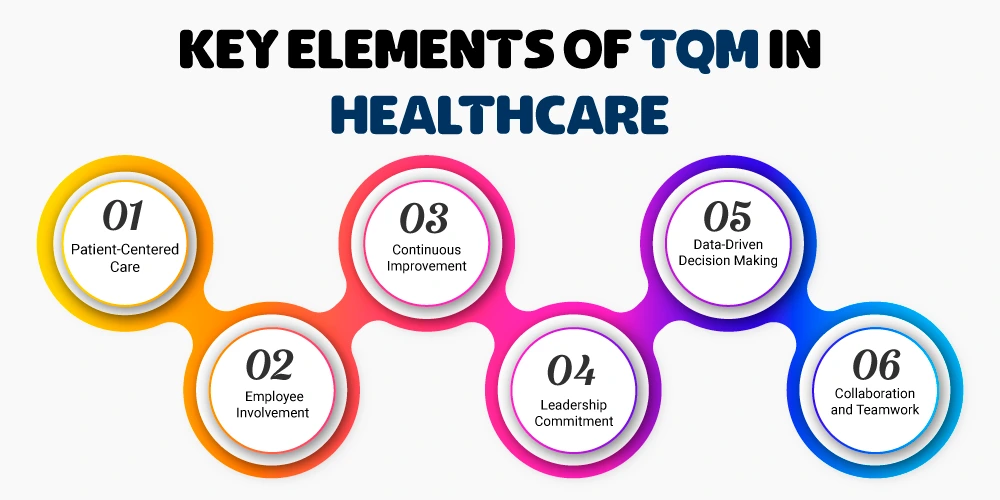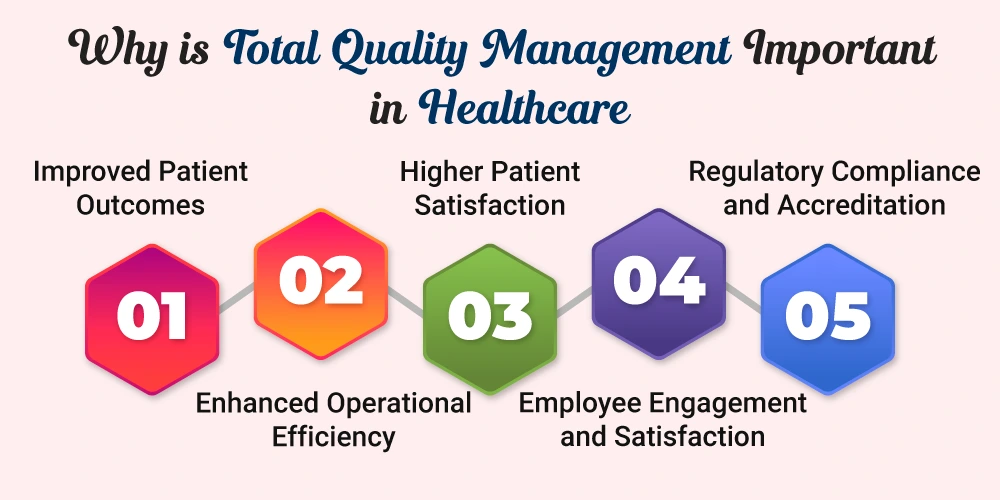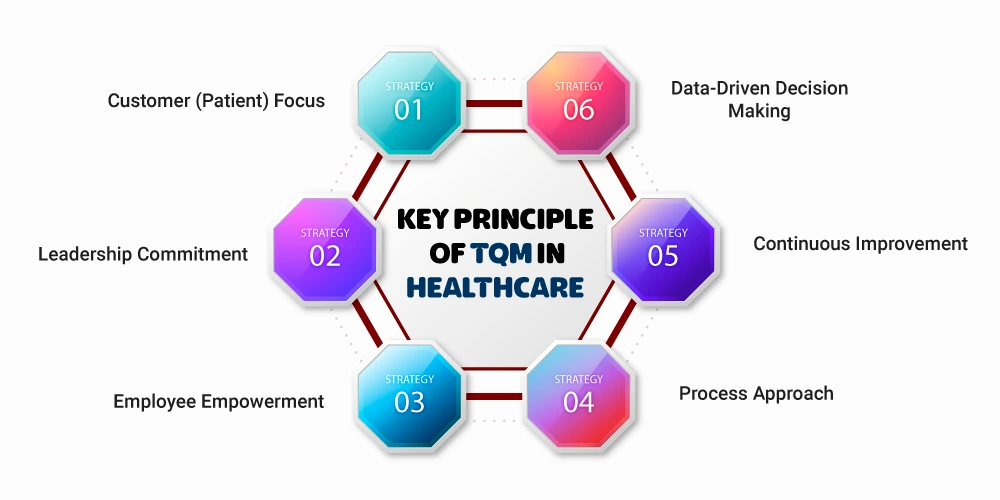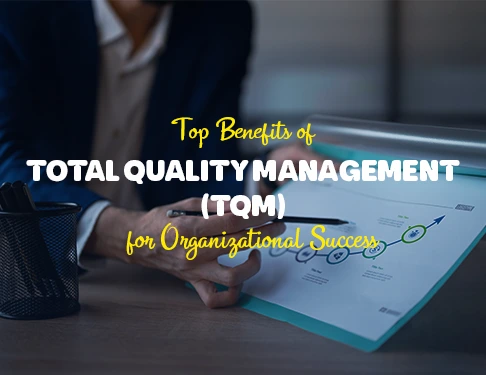Principles of Total Quality Management (TQM)
Total Quality Management (TQM) is a mindset that involves everyone in the organization working toward a common goal: achieving excellence through quality. From....
By AMREP | Posted on April 22, 2025

Healthcare is rapidly evolving, ensuring consistent and high-quality patient care. Total Quality Management (TQM) in healthcare is more than just a buzzword—it is a powerful, systematic approach to improving the efficiency, effectiveness, and patient satisfaction of healthcare services. By focusing on continuous improvement, teamwork, and patient-centered care, TQM aims to elevate healthcare organizations to new levels of excellence.
In this blog, we explore how Total Quality Management is transforming healthcare, the principles behind it, and the benefits it brings to both healthcare providers and patients.
Total Quality Management is a comprehensive management philosophy that strives for long-term success through customer satisfaction. TQM involves all members of an organization in improving processes, products, services, and the culture in which they work. In healthcare, TQM focuses on continuously improving the quality of care provided to patients, the operational efficiency of healthcare facilities, and the satisfaction of staff and stakeholders.

Read More: Principles of Total Quality Management (TQM)
Healthcare is an inherently complex field, with numerous stakeholders, varying patient needs, and constantly changing regulations. Implementing Total Quality Management helps ensure that all of these elements work together harmoniously to achieve the best possible outcomes. Here's why TQM is essential:

The primary goal of any healthcare system is to provide the best possible care to patients. TQM enables healthcare providers to continually assess their services and make data-driven improvements to treatment protocols, reducing errors and improving recovery rates. TQM strategies, such as standardized care pathways, evidence-based practices, and patient feedback, ensure that patients receive optimal care consistently.
By streamlining processes, eliminating waste, and improving resource utilization, TQM helps healthcare organizations operate more efficiently. This can lead to shorter wait times, reduced operational costs, and more efficient use of staff and equipment. TQM focuses on identifying bottlenecks in processes, implementing solutions, and ensuring that everything runs as smoothly as possible.
Patient satisfaction is not just about treating illness; it’s also about creating a positive experience. TQM involves soliciting patient feedback, improving communication, and ensuring that patients are treated with respect and dignity. Satisfied patients are more likely to return for future care and recommend the facility to others, driving long-term success.
Healthcare providers often face high burnout rates and turnover. TQM encourages staff involvement in decision-making and process improvements, creating a more collaborative and engaging work environment. When employees feel valued and have a say in how care is delivered, they are more motivated to provide high-quality services and are less likely to leave the organization.
Many healthcare systems are subject to regulatory standards and accreditation requirements, such as those set by The Joint Commission (TJC) or the Centers for Medicare & Medicaid Services (CMS). TQM helps organizations maintain compliance by creating clear quality standards and continuous monitoring systems. Healthcare facilities that implement TQM can more easily meet and exceed regulatory standards, improving their credibility and reputation.
Total Quality Management is based on a set of core principles that guide organizations in their pursuit of quality improvement. These principles are:

The fundamental principle of TQM is that all efforts should be aimed at satisfying the customer—in healthcare, that means the patient. Healthcare organizations should prioritize patient needs, enhance the patient experience, and foster trust and communication between patients and providers.
Strong leadership is crucial to the success of TQM. Leaders must define the vision for quality improvement, create a culture of continuous improvement, and allocate resources to support TQM initiatives. Without leadership buy-in, TQM strategies will not be effectively implemented.
Employees at all levels must be actively involved in the decision-making process and quality improvement efforts. When healthcare providers encourage their teams to participate in problem-solving and provide them with the tools and training to improve, it fosters a culture of collaboration and innovation.
TQM focuses on improving processes rather than just addressing isolated problems. By analyzing the entire care process—from patient intake to discharge—healthcare organizations can identify inefficiencies, eliminate waste, and standardize practices that lead to better outcomes.
TQM is grounded in the idea of never being "good enough." Continuous improvement is not a one-time initiative, but an ongoing process of evaluating performance, gathering feedback, and making adjustments. This ensures that healthcare organizations remain adaptable and consistently provide the best possible care.
Data and metrics are key to identifying areas for improvement and monitoring progress. TQM in healthcare uses performance indicators, patient satisfaction surveys, quality audits, and clinical data to inform decisions and measure the effectiveness of changes.
Mayo Clinic has implemented TQM practices across its operations to improve patient care and safety. Their approach includes regular audits, interdisciplinary team meetings, and a focus on patient satisfaction through feedback surveys. Mayo Clinic's commitment to continuous quality improvement has helped them maintain high standards of care and remain a leader in healthcare excellence.
Cleveland Clinic has used TQM principles to streamline its operations and improve patient flow. By focusing on process optimization and eliminating bottlenecks, Cleveland Clinic has reduced wait times and improved overall patient satisfaction. Their successful use of TQM principles in management and care delivery has contributed to their ongoing success.
Virginia Mason is known for blending TQM with lean management techniques inspired by the Toyota Production System. Their continuous improvement events (Kaizen) have led to significant reductions in medical errors and enhanced overall patient safety.
Kaiser Permanente uses TQM to drive preventive care and long-term health outcomes. With a strong emphasis on data analytics and integrated electronic health records (EHRs), the organization delivers consistent, proactive, and coordinated care to millions of members.
UPMC promotes a culture of quality by training all staff in TQM principles and encouraging involvement in quality initiatives. Their approach has led to improvements in patient satisfaction scores, safety standards, and care delivery efficiency.
Successfully implementing Total Quality Management (TQM) in healthcare requires strategic planning, cross-functional collaboration, and a long-term commitment to continuous improvement. Here’s a step-by-step guide tailored specifically to healthcare organizations:
For TQM to succeed, leadership must commit to quality improvement and allocate necessary resources.
Healthcare organizations need to train employees at all levels on TQM principles and the importance of quality in patient care.
Conduct thorough audits and process evaluations to identify inefficiencies, bottlenecks, and areas for improvement.
Define clear, measurable goals for quality improvement, such as reduced patient wait times, improved patient satisfaction scores, or lower readmission rates.
Make changes based on data and feedback, and continuously monitor the effectiveness of these improvements through regular audits.
Encourage feedback from all staff members and patients, and continue to innovate and adapt to changes in the healthcare landscape.
Read More: Benefits of Implementing Total Quality Management (TQM)
To successfully implement Total Quality Management (TQM) in healthcare, organizations need to rely on a combination of tools and methodologies that drive continuous improvement, enhance patient care, and ensure operational excellence. Here are the key tools and methodologies that have proven effective in healthcare settings:

The PDCA cycle is a widely used methodology for continuous improvement. It focuses on a structured approach to problem-solving and refining processes.
PDCA helps healthcare teams identify inefficiencies in clinical processes, optimize workflows, and standardize procedures for improved patient care.
Six Sigma aims to reduce process variability and eliminate defects by using data-driven methods. It follows the DMAIC framework (Define, Measure, Analyze, Improve, Control).
Six Sigma is particularly effective in reducing medical errors, minimizing patient wait times, and improving patient safety by enhancing processes with a focus on minimizing defects.
Lean methodology focuses on eliminating waste and improving the value provided to patients. It emphasizes optimizing workflows by removing non-value-added activities.
Lean can streamline administrative processes, reduce patient wait times, and enhance staff productivity, leading to better resource utilization and improved patient care.
Overview: RCA is a problem-solving method used to identify the underlying causes of a problem, rather than just addressing its symptoms. It uses tools like Fishbone Diagrams (Ishikawa) and the 5 Whys.
RCA helps healthcare organizations identify the root causes of incidents like medication errors or patient falls, enabling them to implement corrective measures that prevent future occurrences.
FMEA is a proactive method used to identify potential failure points in a process before they occur. It evaluates the severity, likelihood, and impact of potential failures.
FMEA is particularly useful for identifying risks in clinical processes such as medication administration, surgical procedures, and equipment use, helping prevent adverse events before they happen.
The Balanced Scorecard is a strategic planning and management tool that provides a comprehensive view of organizational performance. It includes four perspectives: financial, customer, internal processes, and learning and growth.
Healthcare organizations use BSC to align their operational and strategic goals, ensuring that they are working toward quality care, patient satisfaction, and sustainable financial performance.
Benchmarking involves comparing your organization's processes and performance metrics with those of other organizations—whether industry leaders or direct competitors—to identify areas for improvement. Healthcare organizations can use benchmarking to compare clinical outcomes, patient satisfaction scores, and operational efficiencies, allowing them to adopt best practices from top-performing hospitals and institutions.
SPC is used to monitor and control a process by tracking performance data and identifying any variations from the desired outcome. It uses control charts to detect abnormalities in real time.
SPC can help monitor healthcare processes like patient wait times, medication errors, and infection rates, ensuring that these metrics stay within acceptable limits.
Implementing Total Quality Management (TQM) in healthcare is a journey that requires dedication, strategy, and the right partnerships. At AMREP, we specialize in Supplier Management Services that help healthcare organizations optimize their supply chains and improve service delivery.
By focusing on quality, efficiency, and collaboration, we ensure that you have the right suppliers in place to support your TQM initiatives. Ready to drive lasting improvements in care and operational excellence? Let AMREP guide you through the process of implementing TQM strategies for better patient outcomes and enhanced organizational performance.
Contact Us To See What We Can Do
Call Us
Mon - Sat 9.00 - 18.00
Sunday Closed


16 - April 2025
16
April
2025
Total Quality Management (TQM) is a mindset that involves everyone in the organization working toward a common goal: achieving excellence through quality. From....

10 - April 2025
10
April
2025
Total Quality Management (TQM) is a business philosophy that prioritizes quality in every aspect of an organization. TQM is more than just a set of practices....

03 - April 2025
03
April
2025
Total Quality Management (TQM) is a comprehensive approach aimed at improving the quality of products and services. It involves all members of an organization in the process of continuous improvement. TQM....
